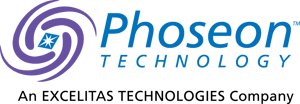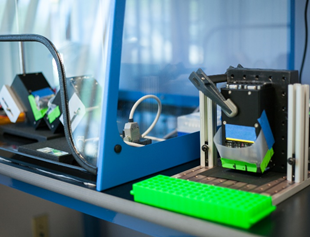UV LED light has proven to be effective in laboratory settings for disinfection and decontamination purposes, making these processes cheaper, faster, and more reliable. UV LED has now revolutionized large laboratories and institutions, however the investment often discourages small laboratory leaders or departments who have not yet joined the movement.
Transforming your lab processes through accessible UV LED technology
While UV LED technology can be a great ally for most laboratories by increasing accuracy and consistency of results while reducing time in experiment trials, there are specific areas of study were UV LED can make a tremendous impact:
- Improving RNA driven protocols and results
Labs that work with RNA are constantly threatened by the feared and ever-present enzyme RNase A. If not properly decontaminated, everything from lab equipment to test samples will be affected by this enzyme. UV LED light sources have proven to be one of the most reliable techniques for decontamination of RNase A, while maintaining cost low and accuracy high.1,2 In addition, implementing UV LED decontamination protocols in equipment prior to experimental runs secures the integrity of RNA libraries or sequences. Some of the common techniques that can greatly benefit from this are: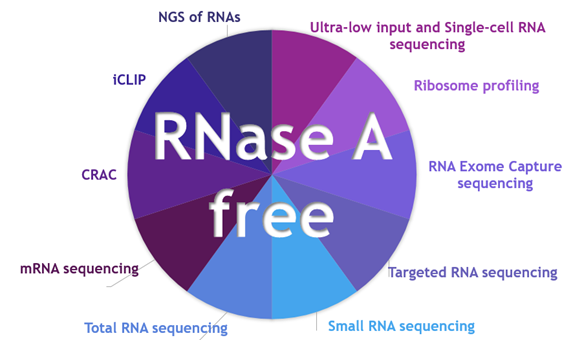
- Vaccine development research and manufacturing
Testing with UV LED can be a fast track to rapid and cost-effective virus inactivation. Whether it is to produce killed vaccines or ensure reliable controls while researching, virus inactivation is an essential step in vaccine development. UV LED technology is user-friendly and provides easily obtainable inactivation protocols for samples. By saving time, and preventing the need to move among differing biosafety levels; UV LED allows more widely available sample testing outside their current environment.
Some additional advantages of UV LED Technology in vaccine development are:
- Readily available to all biosafety levels
- Maintains antibody structures – Preliminary studies indicate
- Speeds lab throughput
- Allows for more testing
- Reduce lab consumables costs
- No potential mercury contamination
- No warm up time
- Rapid and reliable disinfection
- Microbiology laboratories
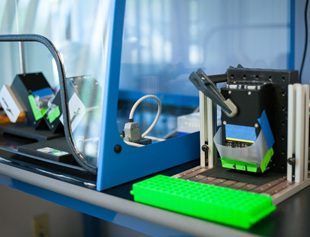
The microbiome existing in manufacturing, R&D, or academia laboratories can be quite harmful to experimental runs and time-consuming for scientists. Whether the purpose is to reuse or to properly dispose of equipment, disinfection is an everyday necessity in microbiology labs. As opposed to other techniques, UV LED technology has proven to achieve complete levels of disinfection in microplates or pipettes3 while leaving no residue behind. This zero-trace result is rarely seen by other disinfection approaches. Phoseon disinfection products have efficiently inactivated viruses, bacteria, and fungi from a variety of surfaces.4
The transition made possible
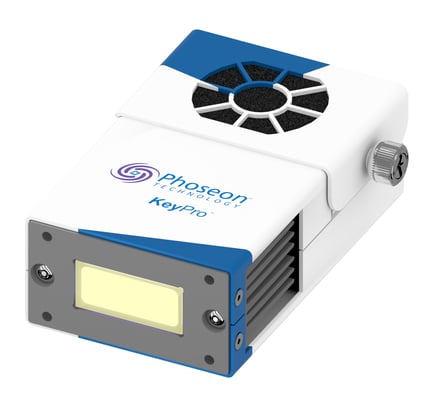 Stepping up into the world of UV LED disinfection/decontamination can be challenging when tied to a small budget. Like most cutting-edge scientific technology, full-functioning systems such as KeyPro KP 100 are an investment, and can prevent small groups from the benefits of increased laboratory ouput.
Stepping up into the world of UV LED disinfection/decontamination can be challenging when tied to a small budget. Like most cutting-edge scientific technology, full-functioning systems such as KeyPro KP 100 are an investment, and can prevent small groups from the benefits of increased laboratory ouput.
Phoseon Technology understands this barrier and has recently launched volume production of the KeyPro™ Explorer UVC LED evaluation kit, a compact UV LED disinfection and decontamination system that fits the needs of small or developing labs at an affordable cost.
KeyProTM Explorer is the perfect transition into UV LED light technology for life sciences purposes. It is a compact, air-cooled, UVC LED system that is the best stepping stone to investigate new applications using UVC light. In addition, its user-friendly approach can be great for introducing students and trainees to learn about top-notch techniques in disinfection, photochemical reactions, decontamination, and more…
Explore additional UVC lamps of diverse sizes and light at Phoseon Technology
- Irreversible inactivation of RNase A on a surface by UV LED; Thompson T, Eliason G, Pasquantonio J; American Society of Human Genetics Scientific Sessions 2017 (poster)
- Rapid inactivation of RNase A by high irradiance UV LEDs; Thompson T, Eliason G, Pasquantonio J; American Society of Cell Biology/European Molecular Biology Organization Scientific Sessions 2017 (poster)
- How Contaminated are Pipetman; Taggard K; Application Document
- Effectiveness of UV Light-Emitting Diodes for Inactivating Biomolecules and Microorganisms; Thompson T; Whitepaper
